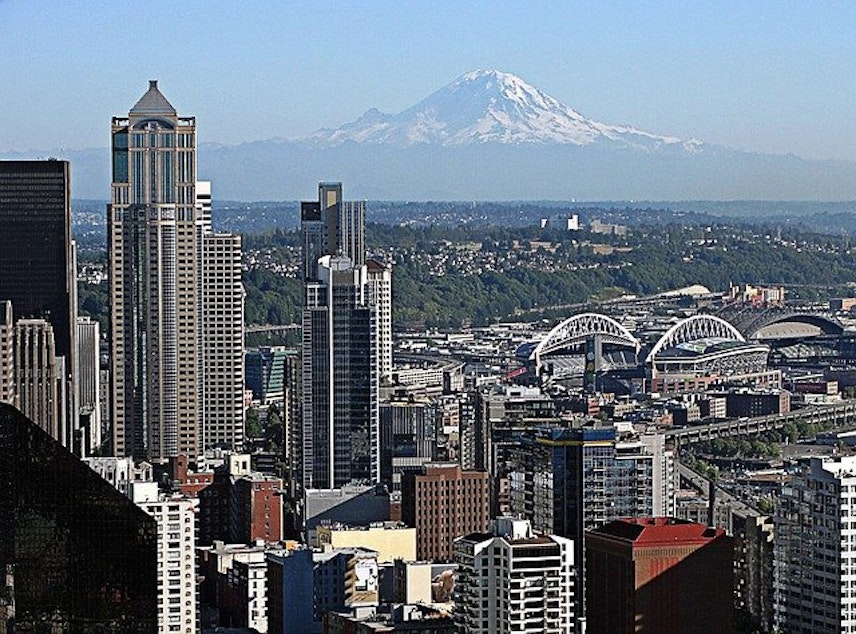Seattle gained a lot of tech workers during the pandemic

During the pandemic, news that tech workers might be migrating away from large metro areas — with high costs of living — concerned some Seattleites.
Had Seattle been losing its highly-paid tech talent? Apparently, to the contrary, according to a new report. Recent layoffs aside, Seattle gained a substantial portion of tech workers over the last three years, the report states.
"For tech talent across all experience levels, Seattle was the No. 2 market," said Chris Volney, managing director with CBRE Consulting, which wrote the report.
Austin took the No. 1 spot for inbound tech migration.
"That didn't particularly surprise me because we're also tracking, during this time, who's hiring and where they're hiring," Volney said. "And a lot of the bigger and smaller tech companies in Seattle, especially in the 2021 into 2022 timeframe, were hiring at a really rapid pace. Just given those job opportunities in the market and the diversity of job opportunities, I think that was probably really attractive to a lot of the younger talent who is just starting out their careers."
Sponsored
RELATED: What can Seattle's 1970s 'Boeing Bust' teach us about recent tech layoffs?
CBRE Consulting defines a "tech worker" as anyone with a tech-related job, no matter where they work. An employee doesn't have to work at a tech company —they could work at a financial services company, for example. Tech workers could include software engineers, product managers, data scientists, etc.
CBRE started polling this data at the beginning of the pandemic, and kept monitoring trends each year. Overall, Seattle gained 11.5% tech workers during this time.
Seattle's pool of young tech workers, like college graduates, increased by more than 15% over 2022, which is higher than any other major city, including California's tech empire. By comparison, Austin and San Francisco saw gains of about 9% among younger workers.
Seattle wasn’t alone in its concerns. Other northern cities fretted about losing tech workers to smaller cities and Sun Belt metros. But overall, that didn’t pan out, Volney said.
Sponsored
"The sky is not falling in some of these bigger markets when it comes to talent exiting," Volney said. "And I think it's a really hopeful sign for some markets like Seattle and San Francisco that their talent supply is being regenerated by young talent coming in, and committing to, and moving to those locations."
CBRE's assessment points to a few other trends around Seattle:
- Seattle is the fourth most diverse job market for female tech graduates (31.6% of all graduates with a tech degree).
- Seattle is popular among millennials, ages 25 to 39. The city had the second-highest growth rate among this generation between 2015 and 2020 (17.3%). Only Austin beat Seattle when it comes to its share of millennials at 25.6% of the total population. Seattle's millennials are 24.7%.
- The Seattle area's average annual tech salary is $122,341. Only the San Francisco Bay Area's average tech salary is higher.
Another takeaway Volney pointed to is that markets also differ when it comes to workers based on life stages, or years of experience.
"Those people that are more mid-to-late career, they really were the ones that were focused more on what I would call smaller-to-medium size, Sun Belt markets. Those markets have maybe fewer job opportunities, but those folks who are further along in their career ... so they're maybe driven more by things like getting a bigger house, more affordability factors, schools — things like that."
Sponsored
Younger workers, he added, are being driven more by the desire to live in a "dynamic, interesting city with all the cultural benefits," like Seattle or San Francisco.
CBRE's data counters some assumptions from the pandemic years — that tech workers were exiting hubs, like Seattle, Austin, or San Francisco (though, while people were certainly being drawn out of big cities, KUOW also reported that Seattle was still drawing newcomers in great numbers). Volney said this notion "spooked" many of their clients, who wondered if these tech hubs would still have the talent they need to hire. But the data, Volney said, told a different story.
RELATED: As people move from big cities, Northwest rural communities see economic boost
"Our research, in a way, did corroborate what some of those headlines said: The Sun Belt cities were seeing a lot of in-migration at the expense of some of the larger coastal markets. But we wanted to put that in context. So even the Bay Area, which saw the largest amount of out-migration, for three years since the pandemic, the total outflow was less than 1% of the workforce. If that continues for another five years, then yeah, maybe we start to become concerned about that. But the Bay Area is still a major talent pool."
Notably, Seattle was an outlier here. The report found it saw a net gain of just over 1% in its total labor force, while many other northern metro areas saw small percentage losses.
Sponsored
"In markets like Seattle, and the Bay Area, most of those people are working at tech companies," Volney noted.





